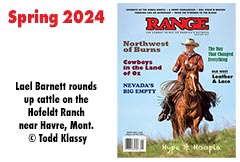

 |
 |
|
OIL vs. WILDLIFE: A PHONY ISSUE Enviros and Feds ignore the facts. By Matthew A. Cronin
The Arctic National Wildlife Refuge (ANWR) in the northeast corner of Alaska, is considered the best onshore prospect in the United States for a major oil discovery. Yet, exploration for oil and gas has not occurred. Contested by environmental groups and government agency biologists because of environmental concerns, particularly about wildlife, the biased, negative
This includes frequent use of oil field roads and structures for travel and to escape from insects. These findings have been published in scientific journals, but they are frequently ignored or downplayed by government biologists and environmental groups. This has been most apparent in the last few years as government biologists publish documents continuing to claim significant impacts of the oil fields on caribou, despite the herdās steady growth. The selective use of information by the antidevelopment groups is apparent in the recent National Research Councilās (NRC, 2003) report, ćCumulative Environmental Effects of Oil and Gas Activities on Alaskaās North Slope.ä During the caribou herdās overall growth from 5,000 animals in the 1970s to 32,000 in 2002, there was a decline between 1992 and 1995. It was most apparent in the western part of the herdās range that contains the oil fields. This was followed by an increase between 1995 and 2000. (See graph, page 68.) The NRC report incredibly ignored the overall herd increase, and attributed the 1992-1995 declines to the oil fields, combined with increased harassment by mosquitoes and flies. In 2001, the U.S. Fish & Wildlife Service also attributed the decline to the oil fields, but this time it was in combination with bad winter weather. It would be obviously biased to say the oil fields only caused a decline in some years and ignore the overall growth of the herd. The biologists therefore came up with secondary impacts such as weather or insects to support their claims. The NRC report also ignored the fact that a neighboring herd, without oil field development in its range, had the same trend of increase, then a slight decrease in the mid-1990s, followed by another increase. This suggests that environmental factors, not oil fields, determine the herdās numbers. In papers published in The Journal of Wildlife Research (Cronin et al., 1997) and The Wildlife Society Bulletin (Cronin et al., 2000, 2001), my co-authors and I suggested that the decline in caribou numbers between 1992 and 1995 was likely due to movements between oil field ranges and undeveloped ranges, and not to impacts from the oil fields. The graph shows that as numbers in the developed (oil field) areas went down, numbers in the undeveloped areas went up by about the same amount. Clearly, movement of the highly mobile caribou between areas is a reasonable interpretation. However, these papers were ignored in the NRC report. Perhaps the most important point regarding Prudhoe Bay is that the management objectives for the central Arctic caribou herd and other wildlife populations have been met during the period of oil field development and operation. Although there may be some subtle impacts on individual animals, the herd, which is the unit of management, has grown. These points were emphasized in a paper published in the journal Biological Conservation (Cronin et al., 1998), but also ignored in the NRC report. It must be acknowledged that the caribou herd that calves in ANWR (the Porcupine caribou herd) differs from the central Arctic herd near Prudhoe Bay in several ways. The Porcupine herd migrates over a larger range in Alaska and Canada. Calves are often born on the coastal plain of ANWR where the best oil prospects are thought to be. Caribou of the Porcupine herd can occur in groups numbering tens of thousands, much larger than the groups of hundreds to thousands in the central Arctic herd at Prudhoe Bay. These factors suggest that the Porcupine herd may be more vulnerable to disturbance and displacement than the central Arctic herd. However, depending on the year, calving occurs from the Yukon Territory, Canada, in the east, to the western edge of the refuge. There is potentially alternative calving habitat should parts of the ANWR be developed. In addition, caribou continue to calve in areas with oil fields, and avoidance of the roads and facilities is limited to a few weeks around the calving period. I believe the experience at Prudhoe Bay indicates that we could achieve the multiple objectives of oil and gas development and maintenance of wildlife populations in the Arctic National Wildlife Refuge. The most obvious point is that impacts from oil development could be mitigated by some simple measures such as minimizing infrastructure and restricting industrial activity during the calving period. However, we must give the public and elected representatives the truth about potential environmental impacts. This has not been happening because of biased reporting by biologists and environmental groups. Clearly this is not unique to the ANWR issue. The Fall 2004 issue of RANGE had an article by Steve Rich documenting similar negative bias by biologists throughout the West. Scientists and stakeholders in the resource industries must continue to aggressively present factual information, and correct biased reporting. It is apparent that different industries, including ranching, oil, mining, fishing, and timber, face the same bias in dealing with environmental issues. Perhaps increased communication and coordinated approaches among industry groups can help.
Matthew A. Cronin is a research associate professor at the University of Alaska, Fairbanks, School of Natural Resources and Agricultural Sciences. Selected papers on caribou and Alaskan oil fields that were not cited in the USFWS letter to Secretary Norton are available via Matthew Cronin, 8415 Jupiter Drive, Anchorage, AK 99507.
|